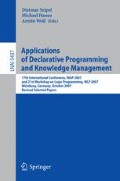Abstract
The rule-based programming paradigm is omnipresent in a number of engineering domains. However, there are some fundamental semantical differences between it and classic programming approaches. No generic solution for using rules to model business logic in classic software has been provided so far. In this paper a new approach for Generalized Rule-based Programming (GREP) is given. It is based on the use of an advanced rule representation called XTT, which includes an extended attribute-based language, a non-monotonic inference strategy, with an explicit inference control at the rule level. The paper shows, how some typical programming constructs, as well as classic programs can be modelled with this approach. The paper also presents possibilities of an efficient integration of this technique with existing software systems.
It describes the so-called Hybrid Operators in Prolog – a concept which extends the Generalized Rule Based Programming Model (GREP). This extension allows a GREP-based application to communicate with the environment by providing input/output operations, user interaction, and process synchronization. Furthermore, it allows for integration of such an application with contemporary software technologies including Prolog-based code. The proposed Hybrid Operators extend GREP forming a knowledge-based software development concept.
The paper is supported by the Hekate Project funded from 2007–2009 resources for science as a research project.
Access this chapter
Tax calculation will be finalised at checkout
Purchases are for personal use only
Preview
Unable to display preview. Download preview PDF.
References
Ligęza, A.: Logical Foundations for Rule-Based Systems. Springer, Heidelberg (2006)
Negnevitsky, M.: Artificial Intelligence. In: A Guide to Intelligent Systems. Addison-Wesley, Harlow (2002)
Liebowitz, J. (ed.): The Handbook of Applied Expert Systems. CRC Press, Boca Raton (1998)
Jackson, P.: Introduction to Expert Systems, 3rd edn. Addison Wesley, Reading (1999)
Giarratano, J.C., Riley, G.D.: Expert Systems. Thomson (2005)
Vermesan, A., Coenen, F. (eds.): Validation and Verification of Knowledge Based Systems. Theory, Tools and Practice. Kluwer Academic Publisher, Boston (1999)
Nalepa, G.J., Ligęza, A.: A graphical tabular model for rule-based logic programming and verification. Systems Science 31, 89–95 (2005)
Newell, A.: The knowledge level. Artificial Intelligence 18(1), 87–127 (1982)
Nalepa, G.J., Ligęza, A.: Prolog-based analysis of tabular rule-based systems with the ”XTT” approach. In: Sutcliffe, G.C.J., Goebel, R.G. (eds.) FLAIRS 2006: proceedings of the nineteenth international Florida Artificial Intelligence Research Society conference, Melbourne Beach, Florida, Artificial Intelligence Research Society, May 11–13, 2006, pp. 426–431. AAAI Press, Menlo Park (2006)
Covington, M.A., Nute, D., Vellino, A.: Prolog programming in depth. Prentice-Hall, Englewood Cliffs (1996)
Fisher, J.R., Tran, L.: A visual logic. In: Symposium on Applied Computing, pp. 17–21 (1996)
Nalepa, G.J., Wojnicki, I.: Visual software modelling with extended rule-based model: a knowledge-based programming solution for general software design. In: Gonzalez-Perez, C., Maciaszek, L.A. (eds.) ENASE 2007: proceedings of the second international conference on Evaluation of Novel Approaches to Software Engineering, Barcelona, Spain, July 23–25, 2007, pp. 41–47. INSTICC Press (2007)
Burbeck, S.: Applications programming in smalltalk-80(tm): How to use model-view-controller (mvc). Technical report, Department of Computer Science, University of Illinois, Urbana-Champaign (1992)
Author information
Authors and Affiliations
Editor information
Editors and Affiliations
Rights and permissions
Copyright information
© 2009 Springer-Verlag Berlin Heidelberg
About this paper
Cite this paper
Nalepa, G.J., Wojnicki, I. (2009). Visual Generalized Rule Programming Model for Prolog with Hybrid Operators. In: Seipel, D., Hanus, M., Wolf, A. (eds) Applications of Declarative Programming and Knowledge Management. INAP WLP 2007 2007. Lecture Notes in Computer Science(), vol 5437. Springer, Berlin, Heidelberg. https://doi.org/10.1007/978-3-642-00675-3_12
Download citation
DOI: https://doi.org/10.1007/978-3-642-00675-3_12
Publisher Name: Springer, Berlin, Heidelberg
Print ISBN: 978-3-642-00674-6
Online ISBN: 978-3-642-00675-3
eBook Packages: Computer ScienceComputer Science (R0)

